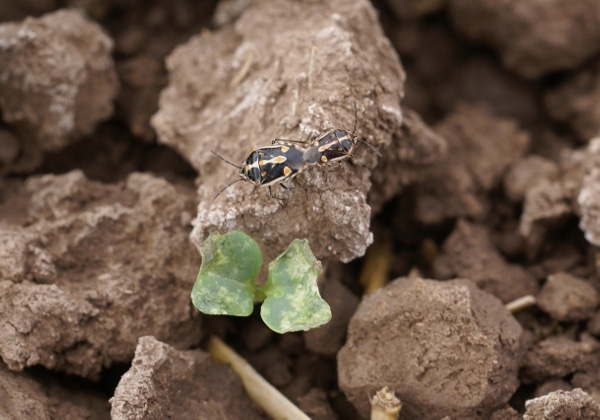
Bagrada bug adult numbers have been relatively light on early broccoli plantings and cauliflower/cabbage transplanted fields in the Yuma and Dome valleys in southwestern Arizona;Bagrada bug numbers could increase this fall;Chemicals are indispensible tools to minimize crop losses due to plant diseases;Kerb herbicide is now available in Arizona and California as a liquid suspension concentrate.
August 26, 2011

The latest Arizona Vegetable Integrated Pest Management Update from the University of Arizona (UA) Cooperative Extension in Yuma, Ariz., released Aug. 24, 2011.
Bagrada bug control on desert cole crops
By John Palumbo, UA Research Scientist and Extension Specialist
Compared to last year, Bagrada bug adult numbers have been relatively light on early broccoli plantings and cauliflower/cabbage transplanted fields in the Yuma and Dome valleys in southwestern Arizona.
Over the summer there were few reports of Bagrada bug adults found in cotton, alfalfa, sudangrass, and other seasonal crops relative to last summer.
Does this suggest that Bagrada numbers will continue to be light once we get into September and acreage begins to increase? It is possible, but I would not bet on it just yet. Remember, it was not until around mid-September last year when it seemed like the clouds opened up and Bagrada bugs dropped from the sky.
Pest control advisors (PCAs) and growers should not become complacent just because they are not finding any Bagrada yet. Rather, it would be wise to assume the bug will eventually show up in some intensity and to prepare for the insect accordingly.
Preliminary research conducted over the past year suggests that direct-seeded and transplanted crops are most susceptible to Bagrada bug infestations during stand establishment.
Research to date also suggests that heavy Bagrada infestation control with insecticides is the most economically viable option to protecting stands and preventing significant yield losses. This includes chemigation with pyrethroids, and using contact insecticides (pyrethroids, Lannate, Lorsban) once plants emerge and the irrigation pipe is pulled.
After stands are established and plant size increases up to the 3-4 leaf stage, or on growing transplants, PCAs may consider alternating to dinotefuron (Venom/Scorpion) for protecting plants from Bagrada feeding. This neonicotinoid will also provide knockdown of adult whiteflies and nymphs.
More information on Bagrada bug control can be found in these research reports conducted in a 2010 field trial and a 2011 greenhouse trial.
Contact Palumbo: (928) 928-782-3836 or [email protected].
Chemicals as plant disease inhibitors
Chemicals as plant disease inhibitors
By Mike Matheron, UA Extension Plant Pathologist
Chemicals are indispensible tools in the ongoing effort to minimize crop losses due to plant diseases. Various active ingredients within fungicides are especially useful for managing diseases caused by many fungal plant pathogens.
Although often not recognized, various substances formed by plants and present before infection provide significant self-defense against potential plant pathogens; ranging from outright immunity through various levels of resistance.
A variety of chemical substances are present on the surfaces of plant parts including leaves, stems, fruit, seeds, and roots. These antimicrobial materials include phenolic compounds, tannins, and fatty-acid like chemicals.
Experiments have shown that some of these compounds have an inhibitory action on certain plant pathogens.
For example, toxic exudates on leaves of a specific variety of sugar beet are present in sufficient concentrations to inhibit spore germination of certain fungal pathogens. Another compound was shown to impart resistance in certain types of tomato plants to powdery mildew by inhibiting spore germination.
Additionally, proteins and enzymes on plant surfaces can inactivate pathogen enzymes that are essential for disease development. These preformed compounds, together with various types of structural plant disease defenses, often drive what we recognize as resistance to diseases in plants.
Even if these plant derived chemical and structural disease defense systems are not sufficient to totally prevent disease, the systems along with disease management tools applied by growers contribute to the overall level of disease suppression obtained on a particular crop.
Contact Matheron: (928) 726-6856 or [email protected].
Kerb SC and Kerb 50WP
Kerb SC and Kerb 50WP
By Barry Tickes, UA Area Agriculture Agent
For the first time in 45 years, Kerb is available in Arizona and California as a liquid suspension concentrate (SC). Aqueous suspension concentrates use little or no hazardous organic solvents and are often more stable and environmentally friendly than many other formulations.
This SC formulation has been used in Europe (Kerb Flo) for several years. Both formulations are available as Kerb 50W, Kerb SC, Pronamide 50 W or Pronamide SC. Users must decide which to use.
The UA has worked with both formulations for about five years to compare efficacy and application. When a good application is made, weed control is the same for both formulations.
The active ingredient, Pronamide, is the same and there is no difference in the weed spectrum or level of weed control. Differences, if any, will likely be in measurement and mixing.
The Kerb 50W we used all of these years contains 50 percent active ingredient per pound and is packaged in water soluble bags. The new SC formulation contains 3.3 pounds of the active ingredient per gallon and is packaged in 2.5 gallon containers. One pound of Kerb 50W, for example, is equivalent to 1.25 pints of Kerb SC.
Contact Tickes: (928) 580-9902 or [email protected].
Sampling adult whiteflies with a vacuum
Sampling adult whiteflies with a vacuum
By Marco Peña, UA research specialist
We have talked in past issues of the Arizona Veg IPM Update about sampling adult whiteflies with a vacuum cleaner. This method is used in chemical efficacy experiments by John Palumbo.
To watch a video describing this procedure, click on this link: Adult Whitefly Sampling with Vacuum.
You May Also Like



